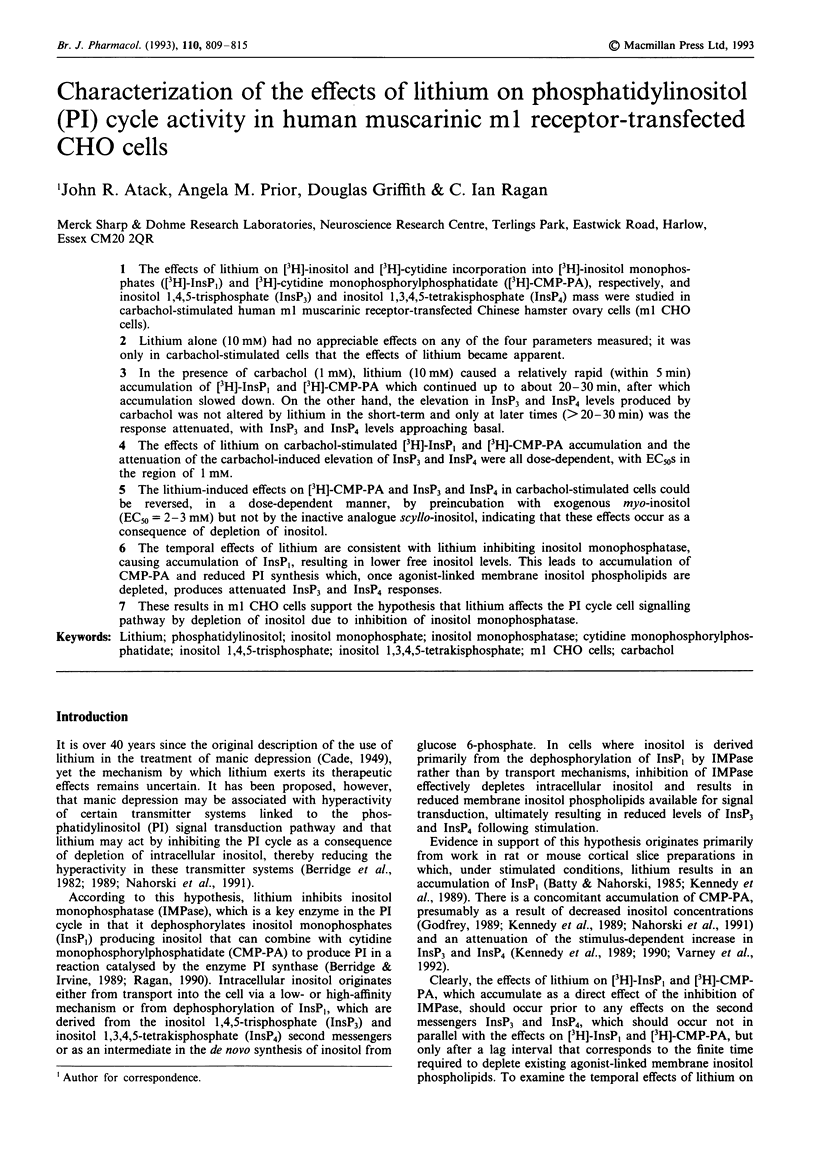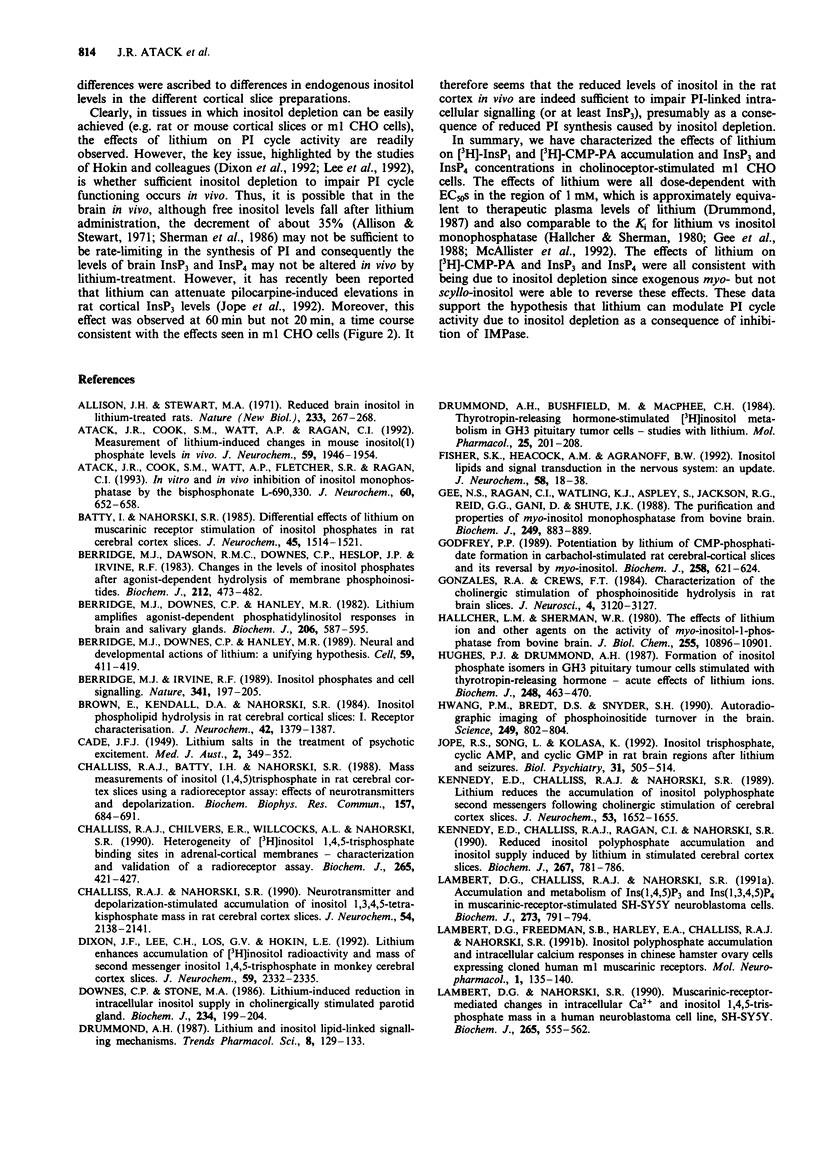Abstract
1. The effects of lithium on [3H]-inositol and [3H]-cytidine incorporation into [3H]-inositol monophosphates ([3H]-InsP1) and [3H]-cytidine monophosphorylphosphatidate ([3H]-CMP-PA), respectively, and inositol 1,4,5-trisphosphate (InsP3) and inositol 1,3,4,5-tetrakisphosphate (InsP4) mass were studied in carbachol-stimulated human m1 muscarinic receptor-transfected Chinese hamster ovary cells (m1 CHO cells). 2. Lithium alone (10 mM) had no appreciable effects on any of the four parameters measured; it was only in carbachol-stimulated cells that the effects of lithium became apparent. 3. In the presence of carbachol (1 mM), lithium (10 mM) caused a relatively rapid (within 5 min) accumulation of [3H]-InsP1 and [3H]-CMP-PA which continued up to about 20-30 min, after which accumulation slowed down. On the other hand, the elevation in InsP3 and InsP4 levels produced by carbachol was not altered by lithium in the short-term and only at later times (> 20-30 min) was the response attenuated, with InsP3 and InsP4 levels approaching basal. 4. The effects of lithium on carbachol-stimulated [3H]-InsP1 and [3H]-CMP-PA accumulation and the attenuation of the carbachol-induced elevation of InsP3 and InsP4 were all dose-dependent, with EC50s in the region of 1 mM. 5. The lithium-induced effects on [3H]-CMP-PA and InsP3 and InsP4 in carbachol-stimulated cells could be reversed, in a dose-dependent manner, by preincubation with exogenous myo-inositol (EC50 = 2-3 mM) but not by the inactive analogue scyllo-inositol, indicating that these effects occur as a consequence of depletion of inositol.(ABSTRACT TRUNCATED AT 250 WORDS)
Full text
PDF






Selected References
These references are in PubMed. This may not be the complete list of references from this article.
- Allison J. H., Stewart M. A. Reduced brain inositol in lithium-treated rats. Nat New Biol. 1971 Oct 27;233(43):267–268. doi: 10.1038/newbio233267a0. [DOI] [PubMed] [Google Scholar]
- Atack J. R., Cook S. M., Watt A. P., Fletcher S. R., Ragan C. I. In vitro and in vivo inhibition of inositol monophosphatase by the bisphosphonate L-690,330. J Neurochem. 1993 Feb;60(2):652–658. doi: 10.1111/j.1471-4159.1993.tb03197.x. [DOI] [PubMed] [Google Scholar]
- Atack J. R., Cook S. M., Watt A. P., Ragan C. I. Measurement of lithium-induced changes in mouse inositol(1)phosphate levels in vivo. J Neurochem. 1992 Nov;59(5):1946–1954. doi: 10.1111/j.1471-4159.1992.tb11031.x. [DOI] [PubMed] [Google Scholar]
- Batty I., Nahorski S. R. Differential effects of lithium on muscarinic receptor stimulation of inositol phosphates in rat cerebral cortex slices. J Neurochem. 1985 Nov;45(5):1514–1521. doi: 10.1111/j.1471-4159.1985.tb07221.x. [DOI] [PubMed] [Google Scholar]
- Berridge M. J., Dawson R. M., Downes C. P., Heslop J. P., Irvine R. F. Changes in the levels of inositol phosphates after agonist-dependent hydrolysis of membrane phosphoinositides. Biochem J. 1983 May 15;212(2):473–482. doi: 10.1042/bj2120473. [DOI] [PMC free article] [PubMed] [Google Scholar]
- Berridge M. J., Downes C. P., Hanley M. R. Lithium amplifies agonist-dependent phosphatidylinositol responses in brain and salivary glands. Biochem J. 1982 Sep 15;206(3):587–595. doi: 10.1042/bj2060587. [DOI] [PMC free article] [PubMed] [Google Scholar]
- Berridge M. J., Downes C. P., Hanley M. R. Neural and developmental actions of lithium: a unifying hypothesis. Cell. 1989 Nov 3;59(3):411–419. doi: 10.1016/0092-8674(89)90026-3. [DOI] [PubMed] [Google Scholar]
- Berridge M. J., Irvine R. F. Inositol phosphates and cell signalling. Nature. 1989 Sep 21;341(6239):197–205. doi: 10.1038/341197a0. [DOI] [PubMed] [Google Scholar]
- Brown E., Kendall D. A., Nahorski S. R. Inositol phospholipid hydrolysis in rat cerebral cortical slices: I. Receptor characterisation. J Neurochem. 1984 May;42(5):1379–1387. doi: 10.1111/j.1471-4159.1984.tb02798.x. [DOI] [PubMed] [Google Scholar]
- CADE J. F. J. Lithium salts in the treatment of psychotic excitement. Med J Aust. 1949 Sep 3;2(10):349–352. doi: 10.1080/j.1440-1614.1999.06241.x. [DOI] [PubMed] [Google Scholar]
- Challiss R. A., Batty I. H., Nahorski S. R. Mass measurements of inositol(1,4,5)trisphosphate in rat cerebral cortex slices using a radioreceptor assay: effects of neurotransmitters and depolarization. Biochem Biophys Res Commun. 1988 Dec 15;157(2):684–691. doi: 10.1016/s0006-291x(88)80304-8. [DOI] [PubMed] [Google Scholar]
- Challiss R. A., Chilvers E. R., Willcocks A. L., Nahorski S. R. Heterogeneity of [3H]inositol 1,4,5-trisphosphate binding sites in adrenal-cortical membranes. Characterization and validation of a radioreceptor assay. Biochem J. 1990 Jan 15;265(2):421–427. doi: 10.1042/bj2650421. [DOI] [PMC free article] [PubMed] [Google Scholar]
- Challiss R. A., Nahorski S. R. Neurotransmitter and depolarization-stimulated accumulation of inositol 1,3,4,5-tetrakisphosphate mass in rat cerebral cortex slices. J Neurochem. 1990 Jun;54(6):2138–2141. doi: 10.1111/j.1471-4159.1990.tb04920.x. [DOI] [PubMed] [Google Scholar]
- Dixon J. F., Lee C. H., Los G. V., Hokin L. E. Lithium enhances accumulation of [3H]inositol radioactivity and mass of second messenger inositol 1,4,5-trisphosphate in monkey cerebral cortex slices. J Neurochem. 1992 Dec;59(6):2332–2335. doi: 10.1111/j.1471-4159.1992.tb10129.x. [DOI] [PubMed] [Google Scholar]
- Downes C. P., Stone M. A. Lithium-induced reduction in intracellular inositol supply in cholinergically stimulated parotid gland. Biochem J. 1986 Feb 15;234(1):199–204. doi: 10.1042/bj2340199. [DOI] [PMC free article] [PubMed] [Google Scholar]
- Drummond A. H., Bushfield M., Macphee C. H. Thyrotropin-releasing hormone-stimulated [3H]inositol metabolism in GH3 pituitary tumor cells. Studies with lithium. Mol Pharmacol. 1984 Mar;25(2):201–208. [PubMed] [Google Scholar]
- Fisher S. K., Heacock A. M., Agranoff B. W. Inositol lipids and signal transduction in the nervous system: an update. J Neurochem. 1992 Jan;58(1):18–38. doi: 10.1111/j.1471-4159.1992.tb09273.x. [DOI] [PubMed] [Google Scholar]
- Gee N. S., Ragan C. I., Watling K. J., Aspley S., Jackson R. G., Reid G. G., Gani D., Shute J. K. The purification and properties of myo-inositol monophosphatase from bovine brain. Biochem J. 1988 Feb 1;249(3):883–889. doi: 10.1042/bj2490883. [DOI] [PMC free article] [PubMed] [Google Scholar]
- Godfrey P. P. Potentiation by lithium of CMP-phosphatidate formation in carbachol-stimulated rat cerebral-cortical slices and its reversal by myo-inositol. Biochem J. 1989 Mar 1;258(2):621–624. doi: 10.1042/bj2580621. [DOI] [PMC free article] [PubMed] [Google Scholar]
- Gonzales R. A., Crews F. T. Characterization of the cholinergic stimulation of phosphoinositide hydrolysis in rat brain slices. J Neurosci. 1984 Dec;4(12):3120–3127. doi: 10.1523/JNEUROSCI.04-12-03120.1984. [DOI] [PMC free article] [PubMed] [Google Scholar]
- Hallcher L. M., Sherman W. R. The effects of lithium ion and other agents on the activity of myo-inositol-1-phosphatase from bovine brain. J Biol Chem. 1980 Nov 25;255(22):10896–10901. [PubMed] [Google Scholar]
- Hughes P. J., Drummond A. H. Formation of inositol phosphate isomers in GH3 pituitary tumour cells stimulated with thyrotropin-releasing hormone. Acute effects of lithium ions. Biochem J. 1987 Dec 1;248(2):463–470. doi: 10.1042/bj2480463. [DOI] [PMC free article] [PubMed] [Google Scholar]
- Hwang P. M., Bredt D. S., Snyder S. H. Autoradiographic imaging of phosphoinositide turnover in the brain. Science. 1990 Aug 17;249(4970):802–804. doi: 10.1126/science.1975122. [DOI] [PubMed] [Google Scholar]
- Jope R. S., Song L., Kolasa K. Inositol trisphosphate, cyclic AMP, and cyclic GMP in rat brain regions after lithium and seizures. Biol Psychiatry. 1992 Mar 1;31(5):505–514. doi: 10.1016/0006-3223(92)90261-w. [DOI] [PubMed] [Google Scholar]
- Kennedy E. D., Challiss R. A., Nahorski S. R. Lithium reduces the accumulation of inositol polyphosphate second messengers following cholinergic stimulation of cerebral cortex slices. J Neurochem. 1989 Nov;53(5):1652–1655. doi: 10.1111/j.1471-4159.1989.tb08566.x. [DOI] [PubMed] [Google Scholar]
- Kennedy E. D., Challiss R. A., Ragan C. I., Nahorski S. R. Reduced inositol polyphosphate accumulation and inositol supply induced by lithium in stimulated cerebral cortex slices. Biochem J. 1990 May 1;267(3):781–786. doi: 10.1042/bj2670781. [DOI] [PMC free article] [PubMed] [Google Scholar]
- LOWRY O. H., ROSEBROUGH N. J., FARR A. L., RANDALL R. J. Protein measurement with the Folin phenol reagent. J Biol Chem. 1951 Nov;193(1):265–275. [PubMed] [Google Scholar]
- Lambert D. G., Challiss R. A., Nahorski S. R. Accumulation and metabolism of Ins(1,4,5)P3 and Ins(1,3,4,5)P4 in muscarinic-receptor-stimulated SH-SY5Y neuroblastoma cells. Biochem J. 1991 Feb 1;273(Pt 3):791–794. doi: 10.1042/bj2730791. [DOI] [PMC free article] [PubMed] [Google Scholar]
- Lambert D. G., Nahorski S. R. Muscarinic-receptor-mediated changes in intracellular Ca2+ and inositol 1,4,5-trisphosphate mass in a human neuroblastoma cell line, SH-SY5Y. Biochem J. 1990 Jan 15;265(2):555–562. doi: 10.1042/bj2650555. [DOI] [PMC free article] [PubMed] [Google Scholar]
- Lee C. H., Dixon J. F., Reichman M., Moummi C., Los G., Hokin L. E. Li+ increases accumulation of inositol 1,4,5-trisphosphate and inositol 1,3,4,5-tetrakisphosphate in cholinergically stimulated brain cortex slices in guinea pig, mouse and rat. The increases require inositol supplementation in mouse and rat but not in guinea pig. Biochem J. 1992 Mar 1;282(Pt 2):377–385. doi: 10.1042/bj2820377. [DOI] [PMC free article] [PubMed] [Google Scholar]
- McAllister G., Whiting P., Hammond E. A., Knowles M. R., Atack J. R., Bailey F. J., Maigetter R., Ragan C. I. cDNA cloning of human and rat brain myo-inositol monophosphatase. Expression and characterization of the human recombinant enzyme. Biochem J. 1992 Jun 15;284(Pt 3):749–754. doi: 10.1042/bj2840749. [DOI] [PMC free article] [PubMed] [Google Scholar]
- Nahorski S. R., Ragan C. I., Challiss R. A. Lithium and the phosphoinositide cycle: an example of uncompetitive inhibition and its pharmacological consequences. Trends Pharmacol Sci. 1991 Aug;12(8):297–303. doi: 10.1016/0165-6147(91)90581-c. [DOI] [PubMed] [Google Scholar]
- Pontzer N. J., Crews F. T. Desensitization of muscarinic stimulated hippocampal cell firing is related to phosphoinositide hydrolysis and inhibited by lithium. J Pharmacol Exp Ther. 1990 Jun;253(3):921–929. [PubMed] [Google Scholar]
- Sherman W. R., Gish B. G., Honchar M. P., Munsell L. Y. Effects of lithium on phosphoinositide metabolism in vivo. Fed Proc. 1986 Oct;45(11):2639–2646. [PubMed] [Google Scholar]
- Varney M. A., Godfrey P. P., Drummond A. H., Watson S. P. Chronic lithium treatment inhibits basal and agonist-stimulated responses in rat cerebral cortex and GH3 pituitary cells. Mol Pharmacol. 1992 Oct;42(4):671–678. [PubMed] [Google Scholar]
- Whitworth P., Kendall D. A. Lithium selectively inhibits muscarinic receptor-stimulated inositol tetrakisphosphate accumulation in mouse cerebral cortex slices. J Neurochem. 1988 Jul;51(1):258–265. doi: 10.1111/j.1471-4159.1988.tb04865.x. [DOI] [PubMed] [Google Scholar]
- Worley P. F., Heller W. A., Snyder S. H., Baraban J. M. Lithium blocks a phosphoinositide-mediated cholinergic response in hippocampal slices. Science. 1988 Mar 18;239(4846):1428–1429. doi: 10.1126/science.2831626. [DOI] [PubMed] [Google Scholar]


